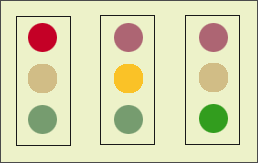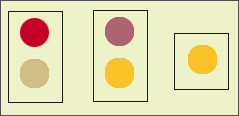

 TUTORIAL: SIGNS AND LANGUAGE
TUTORIAL: SIGNS AND LANGUAGEINTRODUCTION . ICON, INDEX AND SYMBOL . THE SEMIOTIC MODEL . DENOTATION AND CONNOTATION . PARADIGM AND SYNTAGM . ABSTRACTION . METAPHOR . METONYMY . MYTH
A paradigm is a collection of signs. The next picture shows an example of a paradigm.

The elements of a paradigm do not necessarily have meaning in and of themselves. Most often they take on meaning as they are combined into more complex patterns of signs called syntagms. For example, here are three syntagms that might be formed from the paradigm of colored lights.

Syntagms can rather quickly become quite complex. In this example there are six elements in the paradigm -- three colors of lights each of which is either on or off. The particular set of syntagms shown above is only one of many that could be constructed from the paradigm. For example, here are three additional syntagms.

Many different types of rules can be used during the construction of a syntagm. Here the rules involve colors of light chosen (no more than one color is ever used), the positioning of the lights (in this case the lights are organized vertically), and the display of the lights (no more than one light is ever turned on at the same time).
The rules that are used to construct a syntagm can only be applied to the elements of a paradigm. Elements that are not in the paradigm cannot be used. For example, this syntagm could not be constructed from the paradigm shown above.

This symbol, ![]() , is not part of the
paradigm. Therefore, this syntagm,
, is not part of the
paradigm. Therefore, this syntagm, ![]() , cannot be formed from the paradigm,
and neither can the light shown in the previous illustration.
, cannot be formed from the paradigm,
and neither can the light shown in the previous illustration.
The concepts of paradigm and syntagm are central to semiotic theory.
Various approaches to the analysis of communication texts by semiotic
means begin by first identifying the paradigm and sytagms involved, and
semiotic scholars study the way syntagms are formed and used as an
approach to understanding how meaning arises during the communication
process.
![]() paradigm and syntagm
paradigm and syntagm
![]() 1002
1002
![]() 1031
1031
![]() 1033
1033
[sample paradigmatic analysis]
Human beings have a remarkable ability to shape information into the form that is known as the "story." Rather than organizing data in terms of facts and logical relationships, humans tend to organize their information in term of characters, plots, motivations and actions. This type of organization is called narrative.
Perhaps no aspect of human language has been studied so diligently as narrative. These studies are much too extensive even to summarize adequately here, but most readers will have studied literature in high school, and so will have a basic understanding of narrative form.
The syntagmatic analysis that follows is an example of the study of narrative. In this case the analysis applies a theory of narrative structure that was developed by Russian scholar Vladimir Propp. Propp discovered that Russion folk tales all had a similar structure. Today that structure is known as "Propp's Morphology."
[Propp's Morphology:
a sample syntagmatic analysis] ![]() 1032
1032